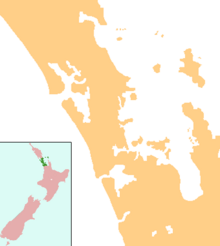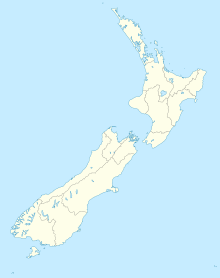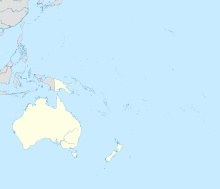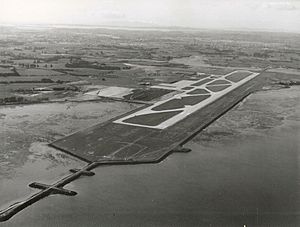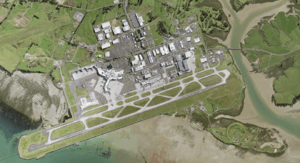Auckland Airport facts for kids
Quick facts for kids
Auckland Airport
Taunga Rererangi o Tāmaki-Makaurau
|
|||||||||||||||
|---|---|---|---|---|---|---|---|---|---|---|---|---|---|---|---|
 |
|||||||||||||||
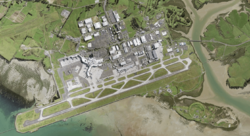
Satellite view of the airport in 2017
|
|||||||||||||||
| Summary | |||||||||||||||
| Airport type | Public | ||||||||||||||
| Owner/Operator | Auckland International Airport Limited (AIAL) | ||||||||||||||
| Serves | Auckland | ||||||||||||||
| Location | Ray Emery Drive, Māngere, Auckland, New Zealand | ||||||||||||||
| Opened | 29 January 1966 | ||||||||||||||
| Hub for | Air New Zealand | ||||||||||||||
| Focus city for | Qantas | ||||||||||||||
| Time zone | NZST (UTC+12:00) | ||||||||||||||
| • Summer (DST) | NZDT (UTC+13:00) | ||||||||||||||
| Elevation AMSL | 7 m / 23 ft | ||||||||||||||
| Coordinates | 37°00′29″S 174°47′30″E / 37.00806°S 174.79167°E | ||||||||||||||
| Map | |||||||||||||||
| Runway | |||||||||||||||
|
|||||||||||||||
| Statistics (2024) | |||||||||||||||
|
|||||||||||||||
|
Source: WAD
|
|||||||||||||||
Auckland Airport (AKL) is a major international airport in Auckland, New Zealand's largest city. It is the biggest and busiest airport in the country. In 2024, more than 18.7 million travelers passed through its gates.
The airport is run by Auckland International Airport Limited. It is located near Māngere, about 21 kilometers (13 miles) south of Auckland's city center. It is the main base for Air New Zealand and a key base for Jetstar.
Auckland Airport is very important for New Zealand. It creates thousands of jobs. In 2000, it handled 71% of all international air travelers coming to and leaving the country. It is also one of only two airports in New Zealand that can handle the huge Airbus A380 planes.
The airport has one main runway, 05R/23L, which is 3,635 meters (11,926 feet) long. This runway can handle about 45 flights per hour. It is currently the busiest single-runway airport in Oceania. There are plans for a new northern runway, but this project has been delayed.
The airport covers a large area of 1,500 hectares (5.8 square miles). It has two terminals: one for international flights and one for domestic flights. There are plans to combine all jet services into one large terminal in the future.
Contents
Airport History: How It Started
The land where Auckland Airport now stands was first used by the Auckland Aero Club. In 1928, the club rented land from a dairy farmer for their small planes. They chose this spot because it was flat, well-drained, and clear of power lines or buildings. Before it became a big airport, it was known as Mangere Aerodrome.
For a while, from 1948, the RNZAF Base Auckland at Whenuapai was Auckland's main airport for civilians. However, it wasn't ideal for newer, larger aircraft. In 1948, a report suggested building a new, bigger airport at either Māngere or Pakuranga. In 1958, the New Zealand Government decided to build the international airport at Māngere.
Construction began in 1960. A lot of the runway was built on land that was reclaimed (taken back) from the Manukau Harbour. The very first flight to leave the new airport was an Air New Zealand Douglas DC-8 in November 1965, heading to Sydney. The airport officially opened with a big air show from January 29 to 31, 1966.
When it opened, the runway was 2,591 meters (8,500 feet) long. It was made longer in 1973, reaching 3,292 meters (10,800 feet). Qantas started the first regular Boeing 747 flights from Auckland in December 1972.
A new international terminal, named after famous pilot Jean Batten, was built in 1977. Before this, all flights used what is now the domestic terminal. In 2005, the international terminal was changed to keep arriving and departing passengers separate for better security.
In 2007, work started on a second runway. This new runway was planned to be 1,200 meters (3,937 feet) long at first. It would have been used mainly by smaller planes, which would free up the main runway for larger jets. This project was put on hold in 2009 due to fewer people traveling by air.
In 2009, the international terminal got an extension called Pier B. This new part added 5,500 square meters (59,200 square feet) and included two gates that could handle the huge Airbus A380 aircraft. In May 2009, Emirates was the first airline to fly the A380 to Auckland.
The domestic terminal also got upgrades in 2013, costing $30 million. These changes improved the drop-off areas, baggage claim, and added new connections to the jetbridges. A new level was added to connect different parts of the terminal.
In 2021, during the COVID-19 pandemic, Auckland Airport had its first financial loss since it became a public company. This happened because air travel dropped a lot.
On January 27, 2023, heavy rain caused flooding in both terminals. The airport had to close for almost 24 hours, and many travelers were stuck. In March 2023, the airport announced plans to replace the domestic terminal. This project is expected to cost $3.9 billion. Airlines have concerns about the high cost, as it might lead to higher ticket prices. In September 2024, the airport announced it would raise NZ$1.4 billion to help fund a NZ$6.6 billion program to upgrade the runway and improve connections between domestic and international flights.
Airport Facilities: What's Inside?
Auckland Airport has two main buildings: the International Terminal and the Domestic Terminal. They are about 500 meters (1,640 feet) apart. You can travel between them using a free shuttle bus or a walkway. The airport has 65 gates in total. 23 of these have jetbridges that connect directly to the plane, and 42 are remote stands where planes park further away.
International Terminal: Your Gateway to the World
The international terminal has three levels. People leaving on flights check in on the ground floor. Then they go up to the first floor for shops, immigration, and security. After that, they head to the departure gates on the second floor. People arriving come in on the first floor, go through duty-free shops, immigration, and then down to the ground floor for baggage claim and customs.
The terminal has 14 gates with jetbridges and several bus gates. Bus gates mean you take a bus from the terminal to your plane.
Each international pier has a special Māori carved gateway called a tomokanga in the arrivals area. There's also an audio recording of a karanga (a traditional Māori welcome call). These welcome travelers to New Zealand.
Domestic Terminal: Flying Around New Zealand
The two parts of the domestic terminal are now connected by a shared shopping area. The Jetstar check-in area is on the western side. The Air New Zealand check-in area is in the middle. There are nine gates with jetbridges in the domestic terminal.
Jetstar uses gates 20–23 for its A320 flights. Air New Zealand's main flights use gates 24–33. Gates 28 to 33 have jetbridges. Smaller turboprop planes from Air New Zealand, Barrier Air, and Air Chathams use the regional section of the domestic terminal. These gates (34–50) are connected by covered walkways, and passengers walk across the tarmac to their planes.
Keeping Passengers Separate: A Safety Measure
Since 1993, airports in New Zealand have had to keep arriving and departing international passengers separate. Auckland Airport was allowed to mix them for a while. But after the September 11, 2001 attacks, new rules meant the airport had to separate them by 2006.
To do this, Auckland Airport built a new departure level on top of the old one. The old floor became the arrivals level. This change was finished in December 2005. It also added more shops and bus gates.
Getting To and From the Airport
Road Connections
Two main roads connect to the airport: State Highway 20A and State Highway 20B. State Highway 20A goes north towards Auckland city. State Highway 20B goes east towards Wiri.
Public Transport Options
- SkyDrive buses: These express buses run between both airport terminals and SkyCity in central Auckland.
- Airport Link: This bus service connects the airport to Puhinui Railway Station. It's the first step towards a faster bus line that will go all the way to Botany Town Centre.
- Park & Ride: This bus service takes people from the airport's long-term parking areas to the terminals. Many airport staff also use it.
Future Rail Plans
There have been many ideas for connecting the airport to central Auckland by train. One idea was to extend an existing train line. Another was to build a new light rail line directly from the airport to central Auckland. This light rail project was planned between 2016 and 2024 but was canceled in January 2024.
Cycling Routes
There are also several bike paths and lanes that connect the airport to nearby areas.
Future Plans for Auckland Airport
The airport has a long-term plan for its future. This plan includes combining the international and domestic operations into one large building. New domestic piers will be built next to the current international terminal. The plan also allows for extending the current international piers and adding new ones.
A new northern runway, about 2,150 meters (7,054 feet) long, is planned. This runway will be able to handle planes like the Boeing 777 and 787. This will free up the longer southern runway for even more large jet flights. New public transport links, including a new train station and line, might also be built.
The plan is divided into four stages. Phase 1 focuses on combining the terminals and improving roads within the next five years. Phase 2 involves building the new northern runway by 2025. Phase 3 includes extending the piers by 2044. Phase 4 will see the northern runway extended to about 3,000 meters (9,843 feet).
In March 2025, the airport started building an alternative runway. This is in preparation for planned work on its main runway in 2030.
Airlines and Destinations: Where You Can Fly
Auckland Airport connects to 23 places within New Zealand and 41 international destinations. These include places in North and South America, Asia, Oceania, and the Middle East. Air New Zealand has the most flights from Auckland, followed by Jetstar and Qantas.
On September 17, 2022, Auckland Airport started flights to New York’s John F. Kennedy Airport. This is one of the world's longest flights, taking about 16 hours when flying east. Air New Zealand and Qantas operate this route.
Passenger Flights
Cargo Flights
| Airlines | Destinations |
|---|---|
| Airwork | Christchurch, Melbourne, Sydney |
| Atlas Air | Honolulu, Sydney |
| China Southern Cargo | Guangzhou, Sydney |
| Tasman Cargo Airlines | Christchurch, Melbourne, Sydney |
| FedEx Express | Guangzhou, Honolulu, Los Angeles, Sydney |
| Parcelair | Christchurch, Palmerston North |
| Qantas Freight | Chicago–O'Hare, Christchurch, Honolulu, Los Angeles, Sydney |
| Singapore Airlines Cargo | Melbourne, Singapore, Sydney |
| Texel Air | Chatham Island, Christchurch, Palmerston North |
Airport Statistics: How Many People Fly?
Annual passenger traffic for Auckland Airport (July 1st - June 30th)
| Year | Domestic | International | Total |
|---|---|---|---|
| 2005 | 4,823,916 | 6,133,899 | 10,957,815 |
| 2006 | 4,958,786 | 6,213,647 | 11,172,433 |
| 2007 | 5,068,794 | 6,373,427 | 11,442,221 |
| 2008 | 5,740,089 | 6,533,385 | 12,273,374 |
| 2009 | 5,653,306 | 7,359,611 | 13,012,917 |
| 2010 | 6,032,410 | 7,415,792 | 13,448,202 |
| 2011 | 6,042,468 | 7,781,819 | 13,824,287 |
| 2012 | 6,236,915 | 7,769,207 | 14,006,122 |
| 2013 | 6,760,537 | 7,755,678 | 14,156,215 |
| 2014 | 6,911,689 | 8,150,396 | 15,062,085 |
| 2015 | 7,198,595 | 8,618,191 | 15,816,786 |
| 2016 | 7,902,059 | 9,358,272 | 17,260,331 |
| 2017 | 8,601,841 | 10,418,732 | 19,020,573 |
| 2018 | 9,263,666 | 10,202,526 | 20,530,048 |
| 2019 | 9,593,625 | 10,506,660 | 21,111,613 |
| 2020 | 7,047,108 | 7,739,260 | 15,521,054 |
| 2021 | 5,844,734 | 602,125 | 6,446,859 |
| 2022 | 4,261,271 | 1,340,875 | 5,602,146 |
| 2023 | 8,087,709 | 7,773,555 | 15,861,264 |
| 2024 | 8,469,457 | 10,059,268 | 18,528,725 |
| Rank | Airport | Passengers | Change |
|---|---|---|---|
| 1 | Sydney | 1,427,535 | |
| 2 | Melbourne | 943,222 | |
| 3 | Brisbane | 765,198 | |
| 4 | Nadi | 540,106 | |
| 5 | Singapore | 539,882 | |
| 6 | Gold Coast | 301,198 | |
| 7 | Shanghai–Pudong | 257,737 | |
| 8 | Rarotonga | 256,101 | |
| 9 | Los Angeles | 251,478 | |
| 10 | Hong Kong | 249,969 | |
| 11 | San Francisco | 218,918 | |
| 12 | Apia | 186,657 | |
| 13 | Kuala Lumpur | 186,389 | |
| 14 | Perth | 182,864 | |
| 15 | Guangzhou–Baiyun | 174,832 |
Accidents and Incidents: Safety at the Airport
Here are some notable events that happened at or near Auckland Airport:
- July 4, 1966 – An Air New Zealand Douglas DC-8 training flight crashed on the runway shortly after takeoff. Two of the five crew members died.
- February 17, 1979 – Air New Zealand Flight 4374 crashed into Manukau Harbour while trying to land. One crew member and one company staff member were killed.
- July 31, 1989 – An Air Freight NZ Convair 340/580 crashed soon after taking off at night. All three crew members died.
- March 12, 2003 – Singapore Airlines Flight 286, a Boeing 747-412, had a tail strike (the tail hit the runway) during takeoff. This happened because of a mistake in calculating the plane's weight.
Images for kids
See also
 In Spanish: Aeropuerto Internacional de Auckland para niños
In Spanish: Aeropuerto Internacional de Auckland para niños
- Auckland Airport Line (proposed)
- List of airports in New Zealand
- List of airlines of New Zealand
- List of the busiest airports in New Zealand
- Transport in New Zealand


